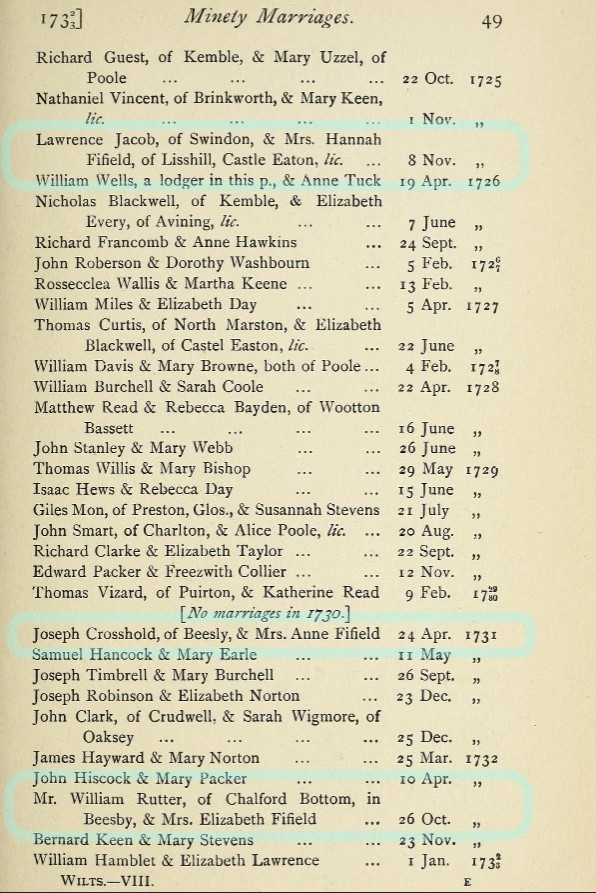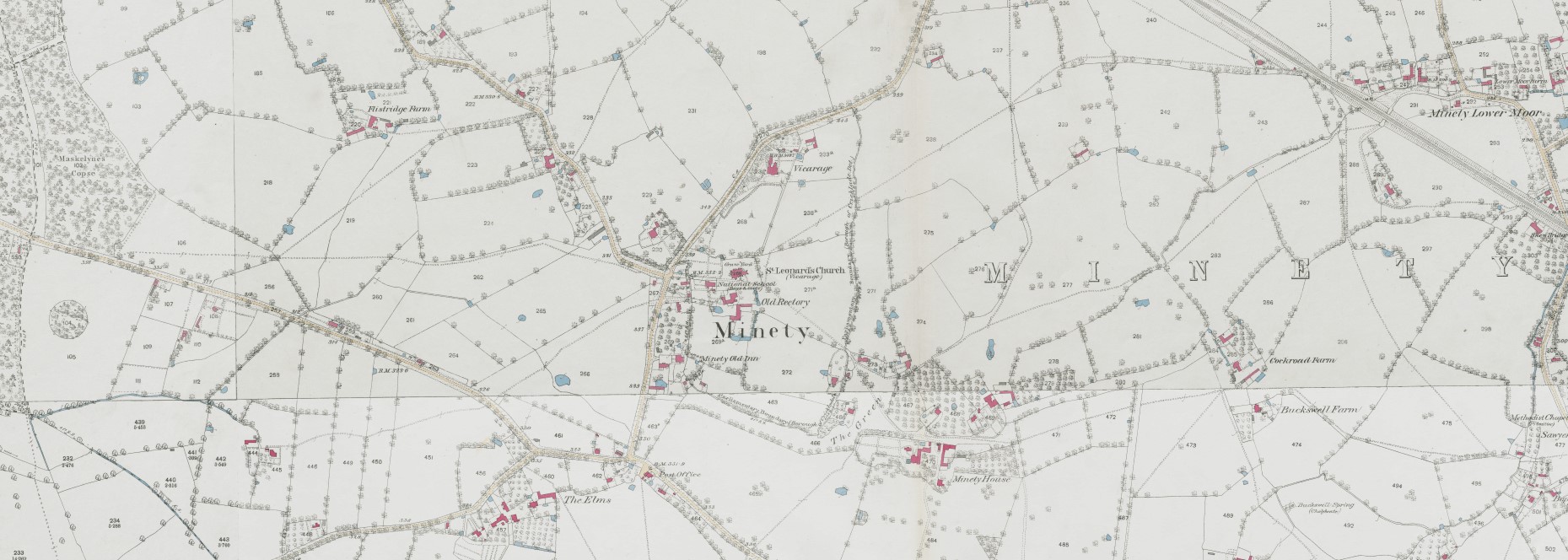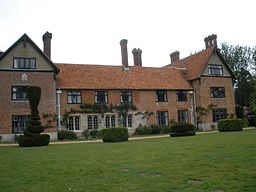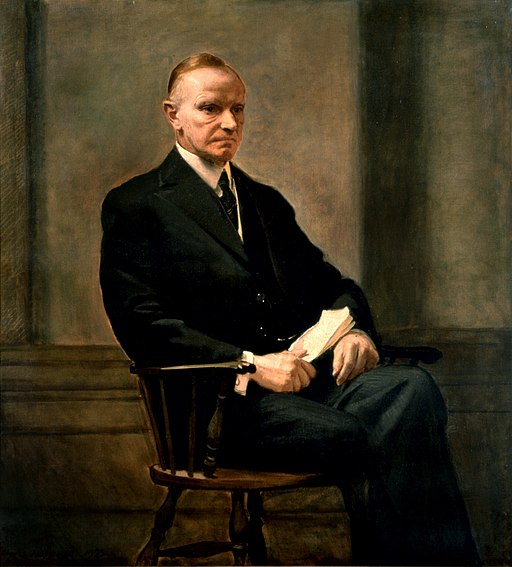The Fifield Family
This is a primarily collection of articles about various branches or people within the Fifield Family. It is still under construction as more information is discovered.
There are various possible spellings of his family's surname, including Fyfielde, Fyfield, Fifeilde, Fiffielde, Fiffield, FFiffield, FFifeld, Fifield and presumably many others. I have adopted Fifield as the collective name for all the variations.
Fifield Name Meaning
English: habitational name from any of various places called Fifield or Fyfield, of which there are instances in Berkshire, Essex, Oxfordshire, and Wiltshire, all so named from Old English fif ‘five’ + hid ‘hide’. (A hide was a measurement of land area.)
Below are some graphical illustrations from Ancestry, of the distribution density of Fifield families as at 1891 found at https://www.ancestry.co.uk/name-origin?surname=fifield, with the location set in the top left corner.


Hampshire is still a prominent location in 1891. Hampshire 20% (99 of 495) , London just pips it at 24% (121 of 495), then Gloucestershire 8% (39 of 495), Surrey 28% (28 of 495), Kent 5% (26 of 495) and Middlesex 5% (24 of 495). Pink is zero representatives of the Fifield name recorded in that county at that date. Lanarkshire in Scotland has 2 individuals recorded, the entire collection in Scotland.
Fifield's were also early settlers within the New World. The Canada map is based on 1911. Ontario had the highest density at 52% (22 of 42), then Saskatchewan 21% (9 of 42), Alberta 17% (7 of 42), British Columbia 5% (2 of 42), Nova Scotia 5% (2 of 42).


The USA distribution map has three possible time slots, 1840, 1880, and 1920. The above map is for 1840 which does not include the spread west. As far as I have ascertained so far, the first Fifield settlers arrived in New Hampshire. From Hampshire to New Hampshire. The predominate distribution of Fifield names is unsurprisingly New England in 1840, although there is a wider spread in later years.

New Hampshire had the highest density at 44% (84 of 190), then Maine 16% (31 of 190), New York 9% (18 of 190), Massachusetts also 9% (17 of 190), Vermont 6% (12 of 190), New Jersey 1% (2 of 190), and Rhode Island 1% (1 of 190). The Mid West also had a smattering, shown in green.

John Fifeld or Fifield, Yeoman of Littleton, Hampshire
Lets start, not at the beginning, but at the end, with his Last Will and Testament.
The following is my attempt to transcribe the probate entry of that Will obtained from The National Archives.
Johannis Fifield - John Fifield
In the Name of God Amen
The fifth day of October 1653 I John Fifield of Littleton in the county of Southampton, Yeoman being in perfect memory thanks be to God xxx xxx this my last Will and Testament in in manner and form following that is to say First I commit my soul into the hands of the Almighty God my xxx xxx him through the xxx of my Saviour Jesus Christ by his blood shed and xxx xxx if blameless and to xxx xxx xxx to not annoy it or hurt it And my body to the Earth thou to xxx xxx xxx xxx of my Saviour Jesus Christ and to be buried at the xxx of my Executer hereinafter mentioned that is to say in xxx xxx xxx xxx of Littleton xxx xxx xxx xxx goods and xxx and xx personal Estate my minds and Will is as followeth.
Item I give and bequeath to the stock of the poor of the parish of Littleton the sum of xxx shillings and eight pence and xxx xxx for the poor of from xxx to xxx.
Item I give and bequeath to my son John Fifield the sum of Twenty Shillings
Item I give and bequeath to my son Robert Fifield the sum of Ten Pounds
Item I give and bequeath to my son William Fifield the sum of Ten Pounds
Item I give and bequeath to my son George Fifield the sum of Ten Pounds
Item I give and bequeath to my son Edward Fifield the sum of Twenty Shillings
Item I give to all by xxx children Forty Shillings apiece being in xxx xxx xxxx
Item I give and bequeath to xxx my dearly beloved wife xxx xxx xxx my stock and household xxx that is upon my own xxx within door and without and xxx xxx and all other and to be equally divided between her and my Executor Except one grass granary in the Kitchen and the Table board in the hall and the Salting trough and through my Will is that xxx xxx xxx standards to the xxx.
Item I give and bequeath to my daughter Elizabeth Hitton wife of Robert Hitton the sum of Twenty Shillings
Item I give and bequeath to John Sharp the son of Edward Sharp the sum of Twenty Shillings and xxx my Will is that my funeral charges be paid by my Executor and which Paid Several Sums and xxxxx my Will is that it be paid within one year of my xxx (death) and that all the rest of my Lands, goods and chattels and personal Estate my debts and funeral charges being paid I give and bequeath to Richard Fifield my youngest son whom I make Executor of this my last Will and Testament paying all xxx all the rest of my Estate xxx xxx I do appoint John Smith and Robert Hitton to be my observers of this my last Will and Testament and for their xxx my Will is that they should have xxx Shillings and Eight pence (Six Shillings and Eight pence ??) apiece In witness xxx hereunto set my hand and xxx John Fifield make his mark applied in the presence of John Duplin xxx
This Will was proved at London xxx xxx and Eighteenth Day of January In the year of our Lord God one Thousand Six Hundred and Fifty Four (English Style) before the judge for Wills and granting administrations lawfully authorized xxx the Oath of Richard Fifield the youngest son and sole Executor named in the said Will To whom administration of all and singular the goods and chattels and debts of the said deceased was granted …
From the Will it appears that John Fifield died in between October 1653 and January 1654.
Surviving him were sons John, Robert, William, George, Edward and Richard together with a daughter Elizabeth and John's dearly beloved, but un-named wife. Richard Fifield, his youngest son is made Executor of the Will.
The daughter Elizabeth is married and could be considered in that time to be the responsibility of her husband, but she still receives the sum of Twenty Shillings, which is one Pound.
There is no Estate or Lands mentioned in the Will so presumably he was a tenant and not a landowner.
Beyond the Last Will and Testament
Where is Littleton?
It is in the county of Hampshire, sometimes know as the County of Southampton, within Budlesgate Hundred. It is North of Winchester, the ancient capital of England, and slightly to the West.
A series of old maps follow, focused of Littleton.
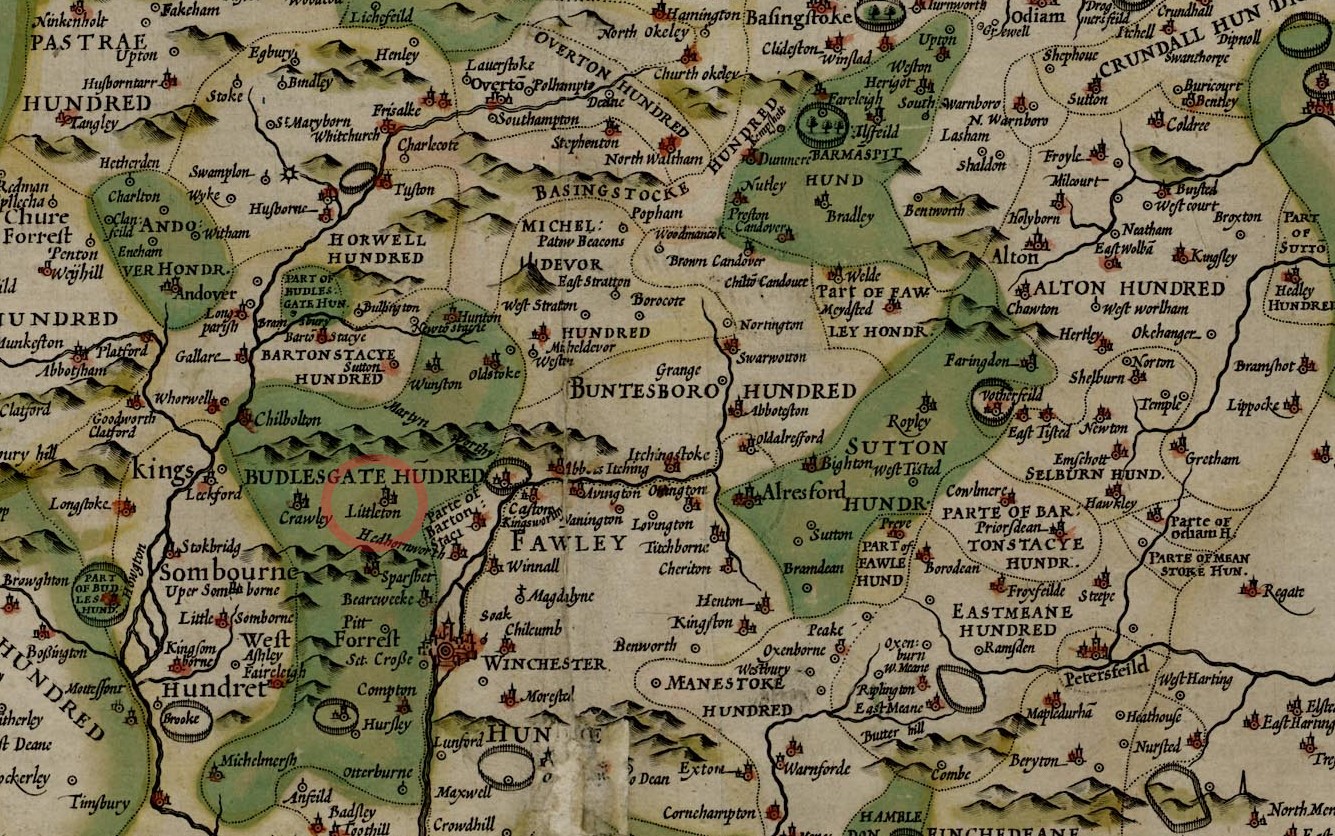 Speed's Map of Hampshire 1611 - Littleton in the Budlesgate Hundred circled
Speed's Map of Hampshire 1611 - Littleton in the Budlesgate Hundred circled
 Morden's Map of Hampshire 1695 - Littleton circled in red and Crawley in blue
Morden's Map of Hampshire 1695 - Littleton circled in red and Crawley in blue
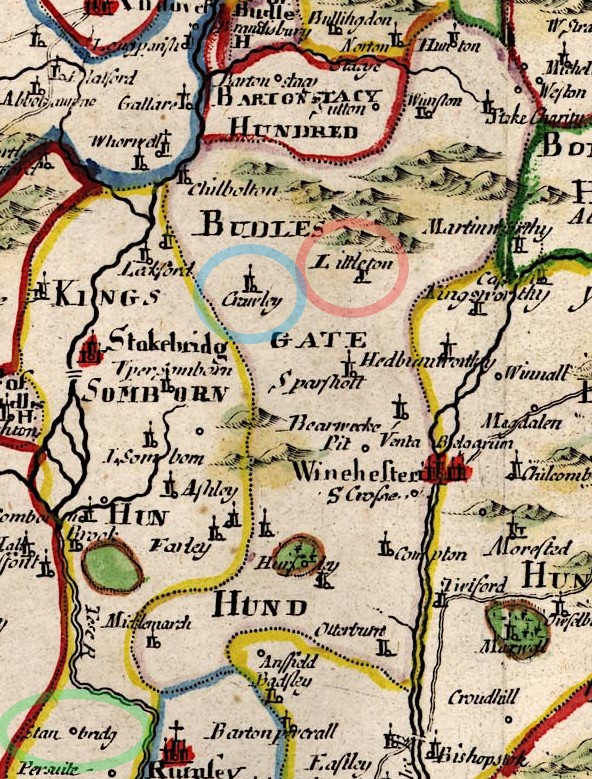 Morden's Map of Hampshire 1695 - Budlesgate Hundred - Littleton circled in red and Crawley in blue. Stan bridg in green bottom left near Rumfey (Now Romsey)
Morden's Map of Hampshire 1695 - Budlesgate Hundred - Littleton circled in red and Crawley in blue. Stan bridg in green bottom left near Rumfey (Now Romsey)
Littleton is the stated home of the Yeoman, John Fifield. It is shown on the earliest map shown in this group, Speed's Map of Hampshire 1611, and is the focus on the following maps as we move through time towards the present.
John Fifield died in between October 1653 and January 1654 so Speed's map is contemporaneous with John Fifield's early life.
Stepping on past his death, is Morden's Map of Hampshire 1695 - Littleton is circled in red and Crawley in blue. Crawley is mentioned as a possible birth place for other Fifield's but not yet part of John's story.
Form the same map but with a different view. we can still see Littleton and Crawley in the Budlesgate Hundred. To the South lies Winchester. Further South, towards the bottom of the image, the following places can be found.
Barton peverall, the name of the school I attended for sixth form, whist living in Romsey.
Eastley, now known as Eastleigh, and the location of Barton Peveril School.
Rumfey, where the f is an s, would then be written as Rumsey and now known as the town of Romsey, one of my childhood homes.
Slightly to the West of Romsey, circled in green is Stan bridg. This is the location of the later Standbridge, an Estate found later in the Fifield Family History.
Jumping forward again is Taylor's Map of Hampshire 1795. No need to circle Littleton this time. Also showing Winchester, Crawley, Headbourne Worthy, Week, and Sparsholt. All places of interest either within the Fifield Family or with regard to my Family Tree more generally.
Then a different image of the same Taylor's Map of Hampshire 1795 but further South, to Romsey, with Stanbridge circled in green again. The clearly demonstrates that place names can evolve and change over time. This is also true of surnames.
Finally, in this set of non Ordinance Survey old maps is Greenwood's Map of Hampshire 1826 showing Littleton, with Northwood and Lainston House. It also shows some named Farms. Throughout this series of maps the constant advances and improvements in map making is very evident, together with the enhanced detail.
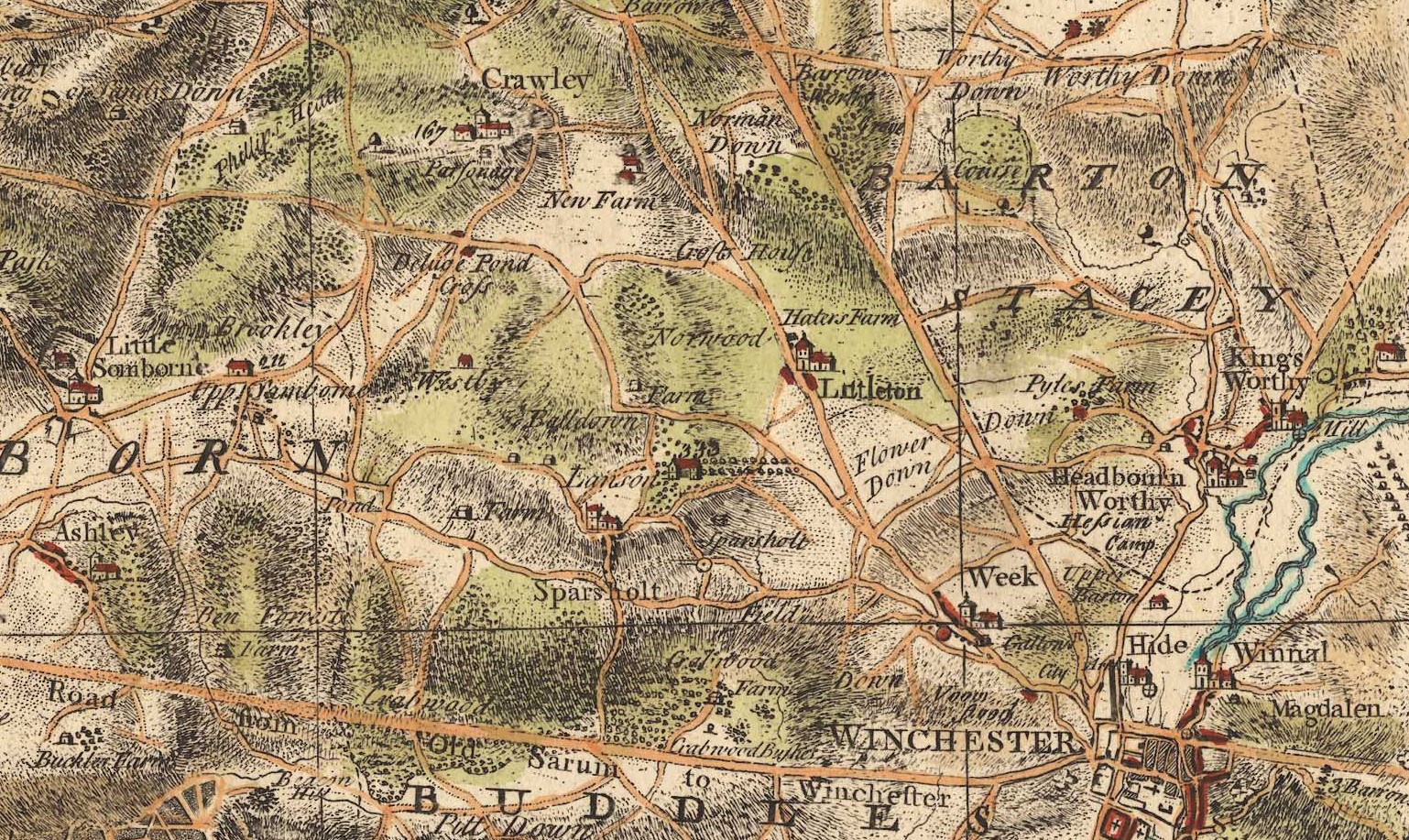 Taylor's Map of Hampshire 1795 - Littleton. Also showing Winchester, Crawley, Headbourne Worthy, Week, and Sparsholt
Taylor's Map of Hampshire 1795 - Littleton. Also showing Winchester, Crawley, Headbourne Worthy, Week, and Sparsholt
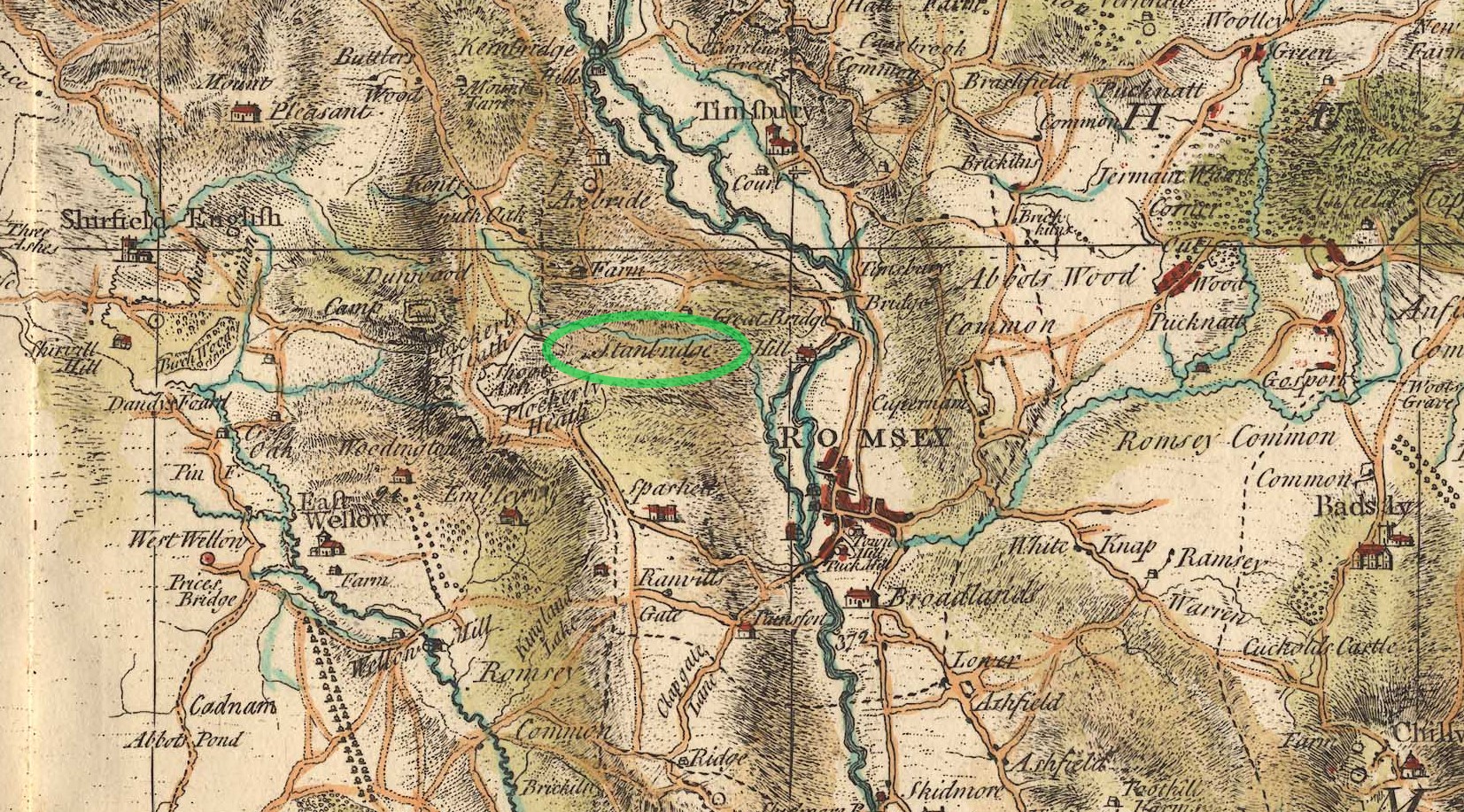 Taylor's Map of Hampshire 1795 - Stanbridge
Taylor's Map of Hampshire 1795 - Stanbridge
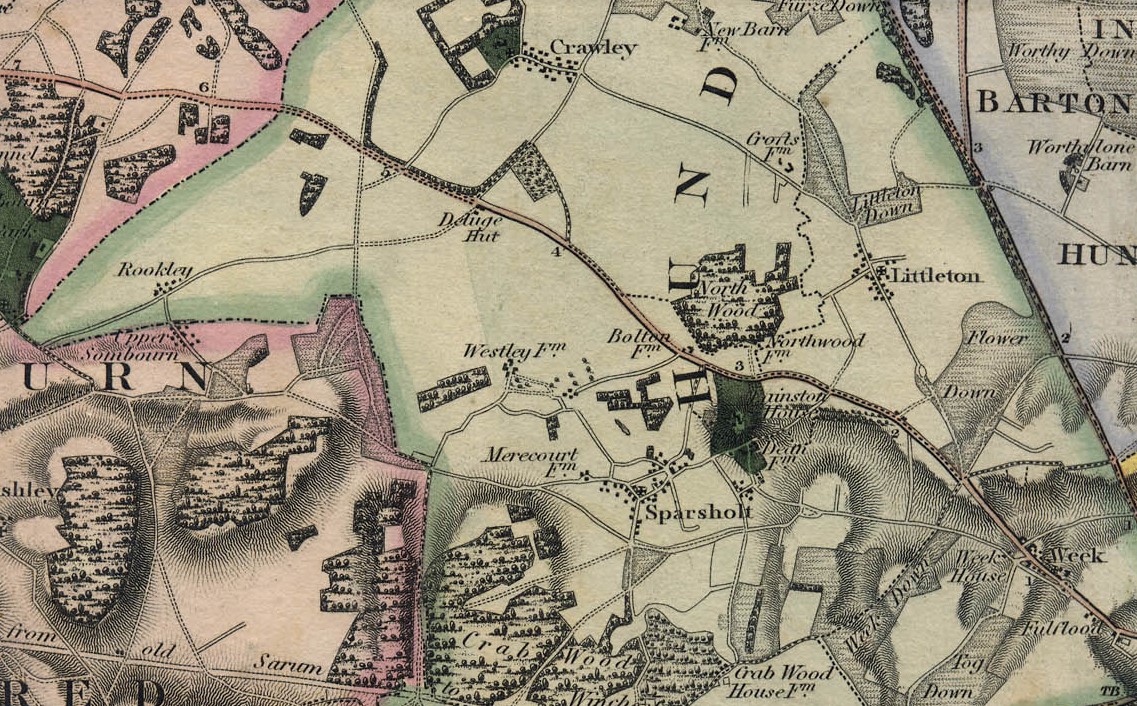 Greenwood's Map of Hampshire 1826 - Littleton, with Northwood and Lainston House. Also some named Farms.
Greenwood's Map of Hampshire 1826 - Littleton, with Northwood and Lainston House. Also some named Farms.
More recent Ordinance Survey maps of the 25" to the mile scale.
Starting with an image zoomed in on the village of Littleton, with significant level of detail. The zooming out to revel the relative position of Littleton and the surrounding area. Click of any of the maps to open the original source in a new window. The OS maps are from the National Library of Scotland.
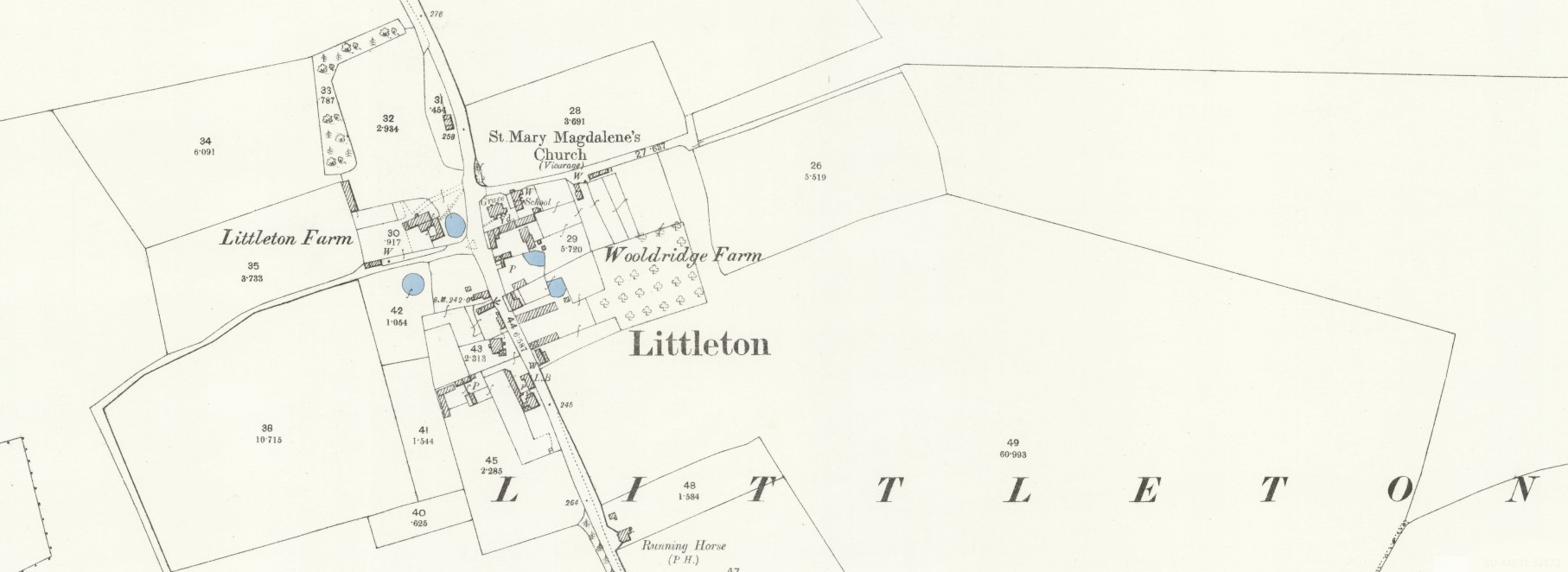 OS 25 Map Littleton - extract from Hampshire and Isle of Wight XL.8, Revised: 1894, Published: 1896
OS 25 Map Littleton - extract from Hampshire and Isle of Wight XL.8, Revised: 1894, Published: 1896
 OS 25 Map Littleton - extract from Hampshire and Isle of Wight XL.8, Revised: 1894, Published: 1896 - With Headbourne Worthy, Flower Down, Harestock Farm, Lainston House, Northwood Park, and Walnut House. Just off the map to the NW is Crawley
OS 25 Map Littleton - extract from Hampshire and Isle of Wight XL.8, Revised: 1894, Published: 1896 - With Headbourne Worthy, Flower Down, Harestock Farm, Lainston House, Northwood Park, and Walnut House. Just off the map to the NW is Crawley
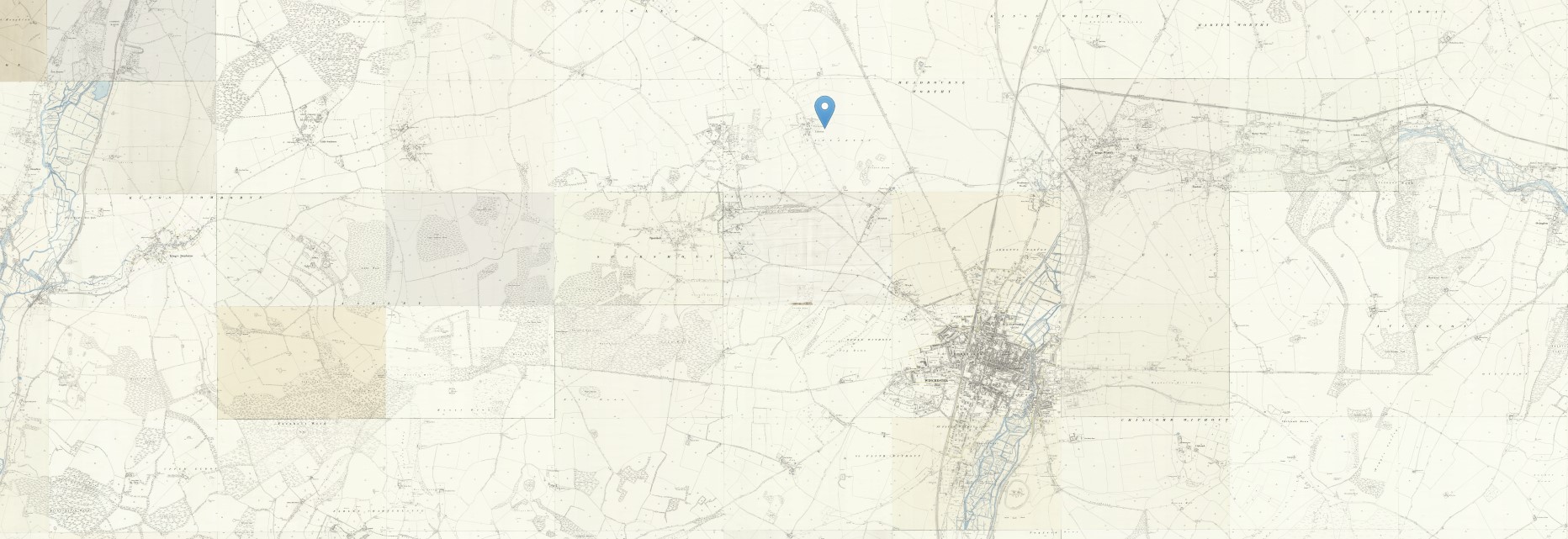 OS 25 Map - Littleton at marker with Winchester to the South
OS 25 Map - Littleton at marker with Winchester to the South
Right up to date with an embedded Google Maps with Littleton, and the route from there to Stanbridge and Romsey.
The route shown and timing is for a car, unfortunately there is not an option for any form of horse or horse drawn transport. A bicycle is however, a option and perhaps may nearly be equivalent, changing the driving time from 31mins on a route of 16.6 miles to a similar route on bicycle of 1hr 29min for 17 miles.
The walking route is different and takes 4 hrs 42 mins for 14.3 miles. Walking was the normal mode of transport for most people in 1654. Only a few people could afford using a horse and even less horses and carriage.
xxxx
Fifield's of Box
1616 – Abbey Church consecrated and 1620 the restoration of the Abbey is completed.
Records in this set, Bath Abbey, start in 1614.

My attempt at transcription of the Parish Record found on Ancestry as Somerset, England, Church of England Baptisms, Marriages, and Burials, 1531-1812
The Contract of Marriage between Robert Fifield of the parish of Box of Wilts & Mary Brookeman of the parish of Batheaston, was published in the Market place of this City on 3 several Market days in 3 xxx on Wednesday 17th on Wednesday 24th of September and on the first of October 1656. } Robert Fifield & Mary Brookeman by Mr John Parse one of the Justices of the Peace for this City Married on the second day of October 1656 in presence of John Brookeman of xxx & William Fyfield of Box in the County of Wilts & me Curate Shepard.
An inconsistency. Checking with other nearby entries, the days are clearly not Sundays, but do look like Wednesday, which could fit with Market Day. However, the day of the week using a Julian Date Calculator appears to be Sunday, but the Julian Calendar had already been replaced by 1656.
Gregorian calendar is the normal calendar we currently use to determine the date. Julian calendar was used from 46 B.C to 1582. It was replaced by the Gregorian calendar.
It was introduced in October 1582 by Pope Gregory XIII. It’s a modification of the Julian calendar, reducing the average year from 365.25 days to 365.2425 days. It shortened the calendar year by 0.0075 days in order to stop the drift of the calendar with respect to the equinoxes. To correct this drift caused by the Julian calendar, the date was advanced ten days in October 1582. Therefore, Friday 15 October 1582 followed Thursday 4 October 1582.
So I can use the Day of the Week Calculator I normally use. Unsurprisingly, still Sundays.
What is clear is that Robert Fifield married Mary Brookeman on the second day of October 1656, in the presence of William Fyfiels of Box and John Brookeman, presumably their respective fathers. Surname spelling seems to vary with time.
Fifield's of Minety, Wiltshire
The Fifield family may have moved to Minety during the first quarter of 1700s.
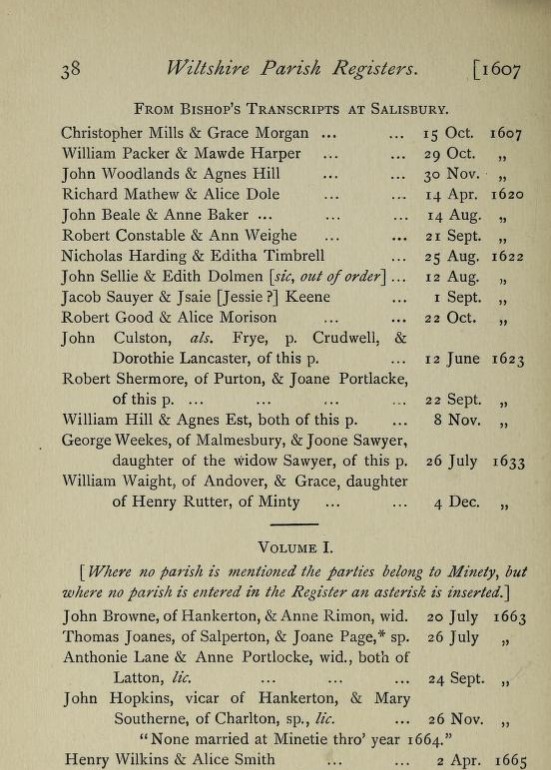 The first entry of a marriage in the Parish records (Bishops Transcripts) was in 1607. Christopher Mills and Grace Morgan married on the 15th October 1607.
The first entry of a marriage in the Parish records (Bishops Transcripts) was in 1607. Christopher Mills and Grace Morgan married on the 15th October 1607.
The Bishops Transcripts records are the source of this information until the 4th December 1633, when William Waigth, of Andover & Grace, daughter of Henry Rutter, of Minety are married.
Volume 1 of the Parish records appear to be next listed, 30 years later, commencing with the marriage of John Browne, of Hankerton, & Anne Rimon, widow, of Minety on 20 July 1663.
There does not appear to be any entries in this transcription of the Parish Registers between 1663 and 1725. Then, like buses, they come in threes.
- Lawrence Jacob, of Swindon, & Mrs Hannah Fifield, of Lisshill, Castle Eaton were married by licence on 8th November 1725.
- Joseph Crosshold, of Beesly, & Mrs. Anne Fifield of Minety on 24th April 1731
- Mr William Rutter, of Chalford Bottom, in Beesby, & Mrs Elizabeth Fifield, of Minety, married on 26th October 1732.
All three appear to be widows, having married into the Fifield family.
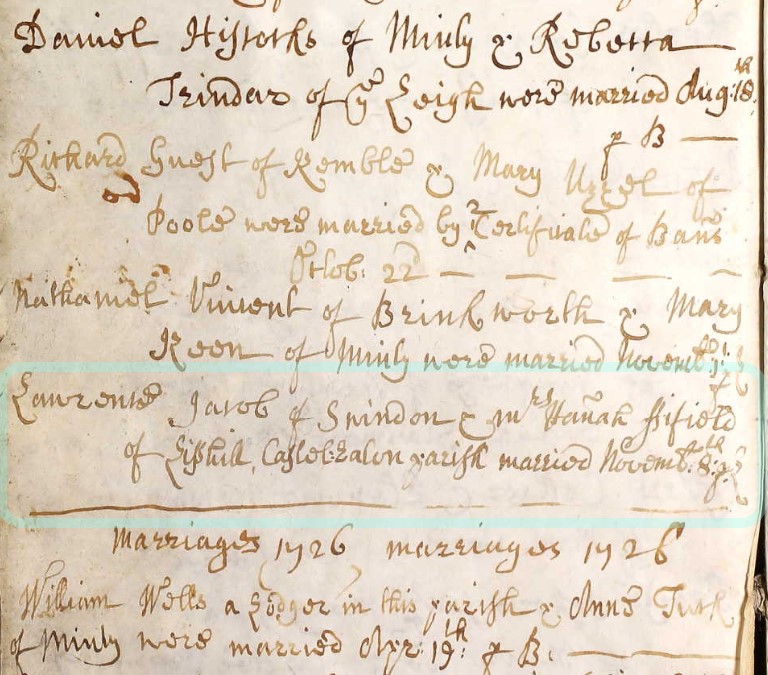 Marriage Lawrance Jacob Mrs Hannah Fifield. The original parish record of Lawrence and Hannah marriage on 8th November 1725.
Marriage Lawrance Jacob Mrs Hannah Fifield. The original parish record of Lawrence and Hannah marriage on 8th November 1725.
There are no further entries in this transcribed volume for Fifield, which goes up to 1812.
The Imperial Gazetteer of England & Wales 1870
MINETY, or MINTY, a village and a parish in Malmsbury district, Wilts. The village stands near the ancient forest of Bredon, and near the Swindon and Gloucester branch of the Great Western railway, 3¾ miles SW of the boundary with Gloucestershire, and 5½ ENE of Malmsbury; and has a station with telegraph on the railway, and a post office under Malmsbury. The parish comprises 3,470 acres. Real property, £7,293. Pop., 182. Houses, 169. The property is much subdivided. The manor belongs to Capt. Arthur Mullings. Minety House is a chief residence. There is a mineral spring. The living is a vicarage in the diocese of Gloucester and Bristol. Value, £300. Patron, the Archdeacon of Wilts. The church is later English, in fair condition, with a tower; and contains a piscina, and a brass and monuments of the Powletts, the Pleydells, and others. Charities, £40. Admiral Penn’s father was a resident.
Source: The Imperial Gazetteer of England & Wales [Wilson, John M]. A. Fullarton & Co. N. d. c. [1870-72].
There is also an extensive article about Minety in British History Online.
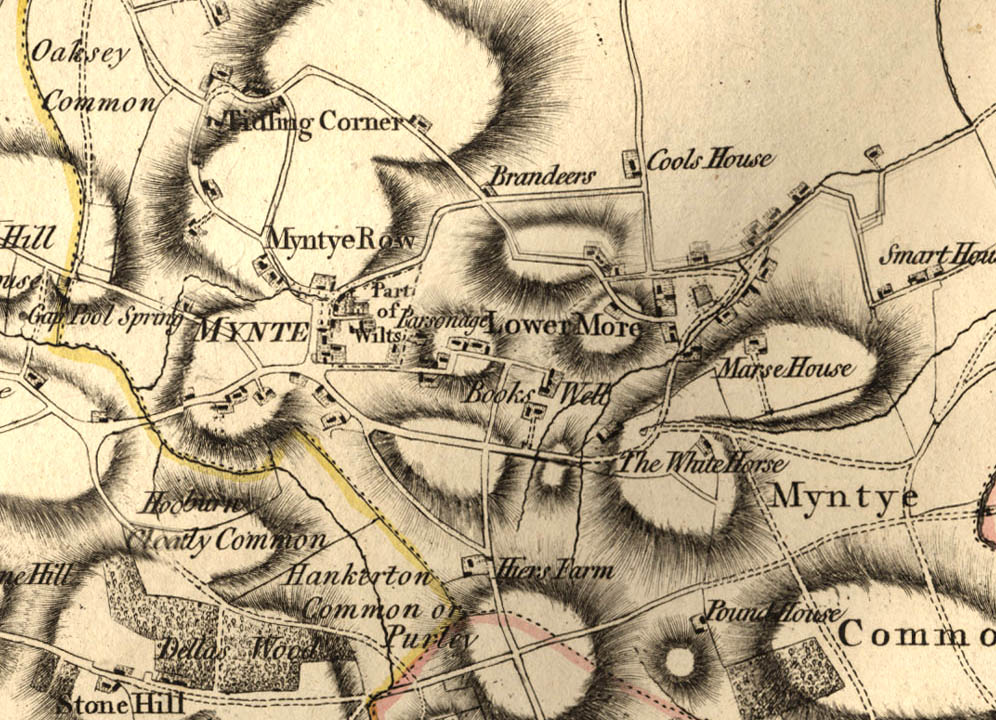 From Andrews' and Dury's Map of Wiltshire, 1773: Minety
From Andrews' and Dury's Map of Wiltshire, 1773: Minety
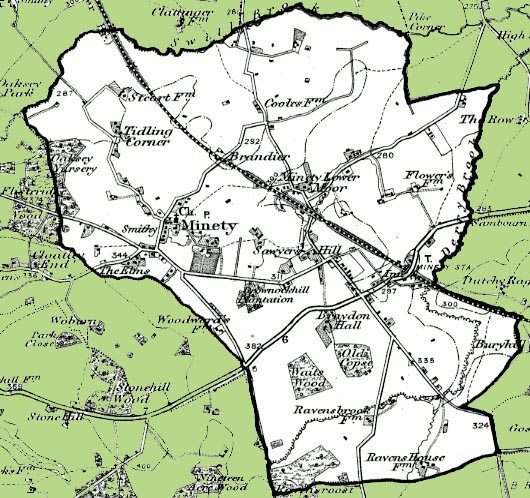 Map of the Civil Parish of Minety. From the Ordnance Survey 1890s revision of the one inch to one mile map. The modern civil parish has been superimposed.
Map of the Civil Parish of Minety. From the Ordnance Survey 1890s revision of the one inch to one mile map. The modern civil parish has been superimposed.
To do ...
There is a will which may have a reference to a Fifield;
Will of Thomas Browne, Gentleman of Minety, Gloucestershire.
I have not yet transcribed it.
There may also be a marriage record which may have William Fifield as a Vicar of Minety.
William Fifield as one of the founders of the great migration.
Standridge is a Tudor Manor House situated near Romsey, Hampshire.
It is also known variously as Standbridge Erles, Stand Bridge, Stanbridge and Stanbridge Earls.
The manor came to my attention whilst researching my Family Tree where an Abraham Hurst was born in 1756, his father, Abraham, was 30 and his mother, Martha, was 30. He married Sarah Pragnell on 16 October 1780 in Houghton, Hampshire. According to Ancestry and other information Sarah Pragnell was born in 1759 in Lockerley, Hampshire, her father, John Fifield, was 40, and her mother, Catharine, was 19. John is recorded as having married a Catharine but not Catharine Pragnell. Hampshire Genealogical Society information from the parish records indicate that on 23 May 1764 in the parish of Romsey John Fifield married Catharine Pearce. He would have been 45 at this time, which is late for the time and therefore possibly a second marriage. His will recognises and illegitimate daughter Elizabeth, another daughter Catharine together with four sons Jno [John] Fifield, Benjn [Benjamin] Fifield, Job Fifield, and Richd [Richard] Fifield. This seems to suggest the the John Fifield and the one in the will are one in the same.
The search continues for more information on both John Fifield and his estates, in particular Standbridge. Hopefully, to establish the relationship between John Fifield and Sarah Pragnell. DNA enhanced trees will also be used, where possible, to establish a link.
Below in information found to date, in chronological order of the information.
Newspaper Article from the British Library
The article is OCR but needs lots of corrections, which I am working through.
Hampshire Chronicle - Monday 11 October 1790
Image © THE BRITISH LIBRARY BOARD. ALL RIGHTS RESERVED.
HAMPSHIRE GAME DUTY.
A LIST of the CERTIFICATES,issued in the County aforesaid, with respect to the said DUTY, between the 1st of July and the 1st of September, both Days inclusive, pursuant to Act of Parliament
DUTY at Ten Shillings and Sixpence each.
Gamekeepers. ¦ By whom deputed. ¦ Manors
FIFIELD, John, jun. ¦ John Fifield, Gent. ¦ ( Standbridge, a. Standbridge Erles, and two undivided third parts of the Manor of Roke )
The same [Guy, Thomas] ¦ E. B. Batson, Esq. ¦ Avon-Tyrell
Transcript of Probate register for the Will of John Fiffield d 1796
From National Archives
Reference IR 26/416/40
Abstract of Will of John Fifield, Gentleman of Standbridge otherwise Standbridge Erles in the parish of Romsey, Hampshire. Proved in the Court of Winchester.
Date of the Probate and Sum sworn 22 March 1796 - £5,000
{
If you want to compare the value of a £5,000 0s 0d Income or Wealth , in 1796 there are four choices. In 2018 the relative:
real wage or real wealth value of that income or wealth is £482,900.00
labour earnings of that income or wealth is £6,371,000.00
relative income value of that income or wealth is £6,805,000.00
relative output value of that income or wealth is £40,730,000.00
}
{Link to Measuring Wealth}
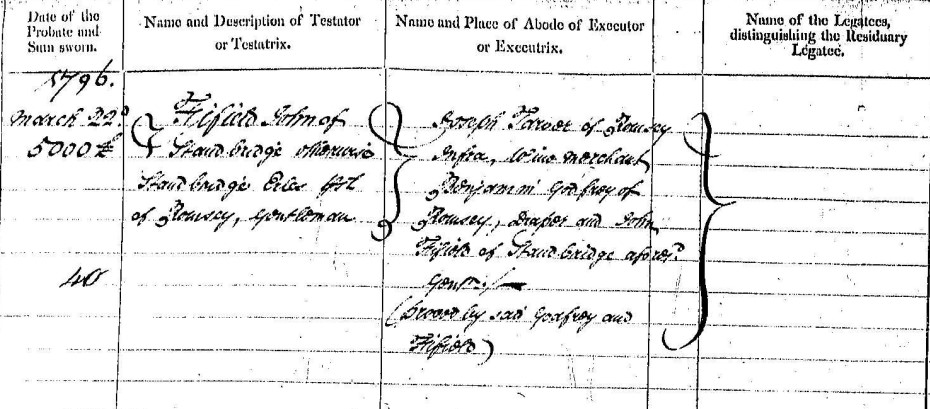
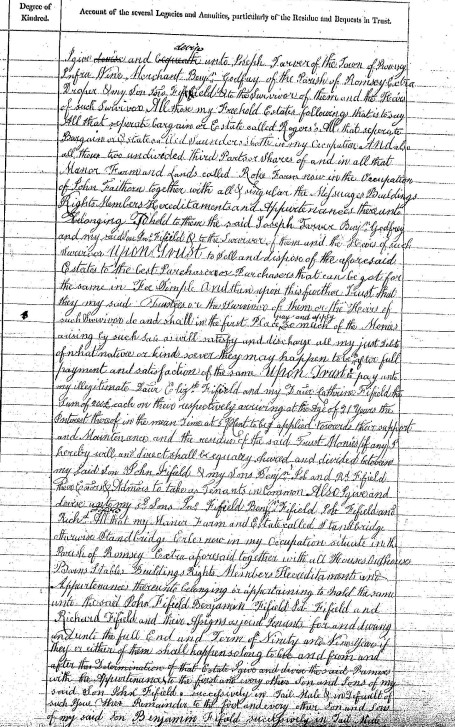
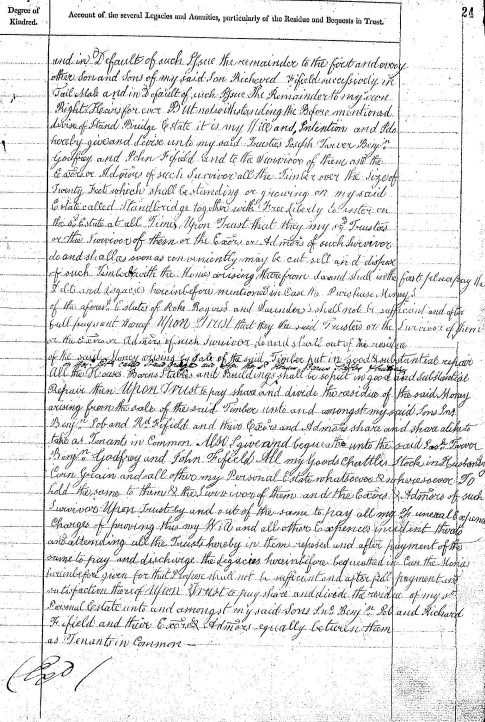
Fifield, John of Standbridge otherwise Standbridge Erles in the parish of Romsey, Gentleman
I give devise and bequeath devise unto Joseph ????? {possibly Tanner} of the town of Romsey Infra Wine Merchant Benjn [Benjamin] Godfrey of the Parish of Romsey Extra Draper & my son Jno [John] Fiffield & to the Survivors of them and the Heirs of those survivors. All those my Freehold Estates following that is too say. All separate xxxxx on Estate called Rogers’s. All that separate ?????? on Estates called Saunders both in my occupation. And also all those two undivided third parts or shares of and in all that Manor Farm and lands called Roke Farm now in the occupation of John Faithorn together with all & singular the xxxxx Buildings Rights Members Hereditaments and Appurtenances there unto belonging ??hold to them the said Joseph xxxxx Benjn [Benjamin] Godfrey and my said son Jno [John] Fifield and to the survivors of them and the heirs of such survivors UPON TRUST to sell and dispose of the aforesaid Estates to the best Purchaser or Purchasers that can be got for the same in Fee Simple and then upon this further Trust that they my said Trustees or the Survivors of them or the heirs of such survivors do and in the first Place ^^ pay and apply ^^ so much of the Monies arising by such sale as will satisfy and discharge all my just Debts of what nature or kind so ever they may happen to be xx after full payment and satisfaction of the same. UPON TRUST to pay to my illegitimate dau¬r [daughter] Elizth [Elizabeth] Fifield and my dau¬r [daughter]Catharine Fifield the Sum of £200 each on their respectively arriving at the age of 21 years the interest thereof in the meantime at 5% xxxx to be applied to their support and Maintenance and the residue of the said Trust monies (if any) I hereby will and direct shall be equally shared and divided my said son John Fifield & my Sons Benjn [Benjamin], Job Fifield, Rd [Richard] Fifield their Ex¬ors & Adm¬ors [Executors & Administrators] to take as Tenants in Common. Also I give and devise unto my xx sons Jno [John] Fifield Benjn [Benjamin] Fifield, Job Fifield and Richd [Richard] Fifield. All that my Manor Farm and Estate called Standbridge otherwise Standbridge Erles now in my occupation situate in the parish of Romsey Extra aforesaid together with all Houses Outhouses Barns Stables Buildings Rights Members Hereditaments and Appurtenances thereunto belonging or appertaining to hold the same unto the said John Fifield, Benjamin Fifield, Job Fifield and Richard Fifield and their off??? as joint tenants for and during and un??? the full End and Term and of Ninety and Nine Years if they or either of them shall happen so long to live and from and after the Determination of that Estate I give and devise the said Premises with the Appurtenances to the first and every other Son and Sons of my said Son John Fifield successively in Tail Male & in Default of such issue the Remainder to the first and every other Son and Sons of my said Son Benjamin Fifield successively in Tail Male & in Default of such issue the Remainder to the first and every other Son and Sons of my said Son Richard Fifield successively in Tail Male & in Default of such issue the Remainder to my own Right Heirs for ever. But notwithstanding the Before mentioned devise of Stand Bridge Estate it is my Will and Intention and I do hereby give and devise unto my said Trustees Joseph ???? Benjn [Benjamin] Godfrey and John Fifield and to the survivor of them and Ex¬ors & Adm¬ors [Executors or Administrators] of such survivors all the timber over the size of twenty feet which shall be standing or growing on my said Estate called Standbridge together with Free Liberty to enter on the ?? Estate at all Times UPON TRUST that they ?? Trustees or the Survivor of them or Ex¬ors & Adm¬ors [Executors & Administrators] of such survivors do and shall as soon as conveniently may be cut sell and dispose of such Timber with the Monies arising therefrom ?? and shall in the first place pay the Debts and Legacies herein before mentioned in Case the Purchase Monies of the aforesaid Estates of Roke, Roger’s and Saunders shall not be sufficient and after full payment thereof. UPON TRUST that they the said Trustees or the Survivor of them or Ex¬ors & Adm¬ors [Executors & Administrators] of such survivors do and shall out of the residue of the said Money arising by sale of the said Timber put in good and substantial repair All the Houses Barns Stables and Buildings ^^ on ??? Est [Estate] called Standbridge ??? after the ?? House Barns Stables ?????? ^^ shall be so put in good and substantial Repair then UPON TRUST to pay share and divide the residue of the said Money arising from the sale of the said Timber unto and amongst my said sons Jno [John] Benjn [Benjamin] Job and Richd [Richard] Fifield and their Ex¬ors & Adm¬ors [Executors or Administrators] share and share alike to take as Tenants in Common Also I give and bequeath unto the said Josh [Joseph] T???? Benjn [Benjamin] Godfrey and John Fifield All my Goods Chattels Stock in Husbandry Corn Grain and all other my Personal Estate whatsoever and wheresoever To hold the same to them & the survivor of them and the Ex¬ors & Adm¬ors [Executors & Administrators] of such Survivor UPON TRUST by and out of the same to pay all my Funeral Expenses Charges of this my Will and all other Expenses incident thereto and attending all the Trusts hereby in them ???? and after payment of the same to pay and discharge the Legacies hereinbefore bequeathed in Case the Monies hereinbefore given for that Purpose shall not be sufficient and after full payment and satisfaction thereof UPON TRUST to pay share and divide the residue of my ?? Personal Estate unto and amongst my said sons Jno [John] Benjn [Benjamin] Job and Richd [Richard] Fifield and their Ex¬ors & Adm¬ors [Executors & Administrators] equally between them as Tenants in Common.
Estates extracted from Will;-
Rogers’s:
Saunders: Parish: Awbridge: All Saints
Manor Farm: <michelmarsh?> <timsbury?> Parish: Michelmersh: St Mary Parish: Timsbury: St Andrew
Roke Farm: Parish: Awbridge: All Saints http://www.romseynet.org.uk/genealogy/2011/rokemanor.pdf
Standbridge otherwise Standbridge Erles (aka Stand Bridge and Stanbridge Earls): - Parish: Romsey: St Mary & St Ethelflaeda - https://www.arcgis.com/home/webmap/viewer.html?webmap=67bce0ed36dd4ee0af7a16bc079aa09a
https://historicengland.org.uk/listing/the-list/list-entry/1166424
https://www.parksandgardens.org/places/stanbridge-earls
Detailed History
Stanbridge Earls is reputed to be the place where Ethelwulf, King of the West Saxons and father of Alfred the Great died and was buried. However, it has not been proven. After 1066 various families possessed the estate. It was well-endowed, with fishing rights in the River Test, arable and meadowland, orchards and plentiful woodland.
Even so, in the time of John Fifield (the late-18th-century) it was allowed to fall into decay and become ruinous. The estate was saved by a number of owners in the early-20th-century, who were prepared to invest money in restoring and beautifying it. In this way a scenic area south of the house was created, a variety of plants, some exotic, some Alpine, were introduced into the gardens and more trees were planted. Facilities for sports were also introduced.
Family extracted from Will;-
Elizabeth Fifield (illegitimate), John Fifield, Benjamin Fifield, Job Fifield, Richard Fifield, Catharine Fifield. His wife Catherine (1731 - 1800) does not appear to be mentioned in the will, despite still being alive at the time of her husbands death.
| Name | Birth and death | age at Father's death 1796 | age at death |
surviving at Tithe Apportionment - 1840 |
Heir at 1840 | |
| Elizabeth Fifield (illegitimate) | d | 1764 - 1817 | 32 | 53 | No | |
| John Fifield | s | 1766 - | 30 | |||
| Benjamin Fifield | s | 1767 - 1799 | 29 | 32 | No | |
| Job Fifield | s | 1769 - 1840 | 27 | 71 | Yes | |
| Richard Fifield | s | 1770 - 1815 | 26 | 45 | No | |
| Catharine Fifield | d | 1771 - 1846 | 25 | 75 | Yes |
Dates added from ancestry
There next line of investigation let to the Tithe Apportionment and Maps.
The estates are located in;-
Rogers’s: Not located yet
Saunders: Parish: Awbridge: All Saints
Manor Farm: Parish: Michelmersh: St Mary or Parish: Timsbury: St Andrew
Roke Farm: Parish: Awbridge: All Saints
Standbridge otherwise Standbridge Erles - Parish: Romsey: St Mary & St Ethelflaeda
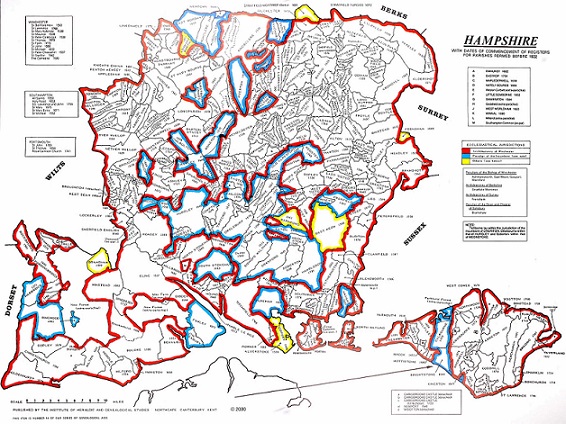
Above is a map of the Parishes of The County of Hampshire.
Our search started with Job Fifield in Michelmersh and resulted in finding over 10 plots attributed to him as both owner and occupier. It was in a strange and isolated section of the Parish of Michelmersh totally disconnected from the main parish, almost an island surrounded by the Parish of Romsey. The lands were known Tithe Free Lands Monks and the buildings Monk's cottages. The map below shows the current parish segment. Plot 830 of the Tithe Map is described as 'Tithe Free Lands Monks, Three Cottages & Gardens' Landowner; Job Fifield, Occupier; William Young and Others. Job's lands in this area include copses, orchards, arable, meadow and pasture in excess of 23 acres, in addition to the properties, part of a road and part of the River Test. It is currently a mystery as to why there are isolated elements of the Parish of Michelmersh.
Searching for information as to why Michelmersh Parish has some Isolated outliers I found a site with transcriptions of parish records, some of which may be useful in this research and are accordingly captured here, with links back to the source. (Moved to John Fifield d 1796)
The same site states in its 'A Potted History of the Villages';
8,000 years ago, close to the end of the Ice Age, one of the largest Middle Stone Age settlements in Great Britain flourished nearby on Broom Hill, Braishfield.
There is much evidence of habitation in Saxon times when kilns in Michelmersh produced cooking pots, pitchers.
985 - The original parish of Michelmersh, which included Braishfield and the whole of Awbridge was granted by King Aethelred II (‘Ethelred the Unready’) to Aelferd as a gift for life. It does not appear in Doomsday as it remained Crown Property until …
1043 - King Ethelred died his wife Queen Emma gave the Michelmersh Estates to the Priory of St Swithun’s Winchester, possibly in gratitude for not overheating the nine (red-hot?) ploughshares, which she is reported to have walked over barefoot in the cathedral to prove her innocence of the charge of criminal familiarity with Bishop Alwyn.
1200's - Michelmersh Church was built, or rebuilt. Timsbury Church also dates from this period.
1205 - The first mention of Michelmersh Manor Farm. Michelmersh Manor was a large grange with a fortified gate house, Great Hall, chambers for visiting monks and squires, an office for the bailiff, kitchen, Chapel, parts of which are still extant – a chamber, a gardrobe for the prior, etc.
1850 - Act passed for purchase of Redbridge-Andover canal and turning it into a Railway.
1855 - Braishfield becomes a separate parish
1877 - Awbridge becomes a separate parish
Moving again to the tithe apportionments, but in the Parish of Romsey instead of Michelmersh, Job Fifield has as landowner and occupier over 200 acres with him living in Roke Farm, plot 877 . Rogers Field is plot 893. {Is this part of the Roger's Estate mentioned in the John Fifield d 1796 will?} West Park Farm is also mentioned, in part. He is joint landowner with Charles John Hall, and occupier of a further 162 acres. Charles John Hall was recorded as occupier of a further 238 acres and the house garden yard and buildings at plot 908, Stanbridge Farm. William Fifield was recorded as the lifeowner of plot 1082, Brickkiln and yard, on the Hundred Romsey and freeholder nearby of plot 1042 Brick field, or Bresk Field, arable. Job Fifield also rented some fields adjacent to Viscount Palmerston's land near Romsey, from Anne Julia Daman.
Charles John Hall married Catharine Fifield, a daughter of Job Fifield, on 15 July 1826 in Romsey, Hampshire, and instantly became part of the Fifield family or dynasty, with between them, about 640 acres, of prime Hampshire land under their control.
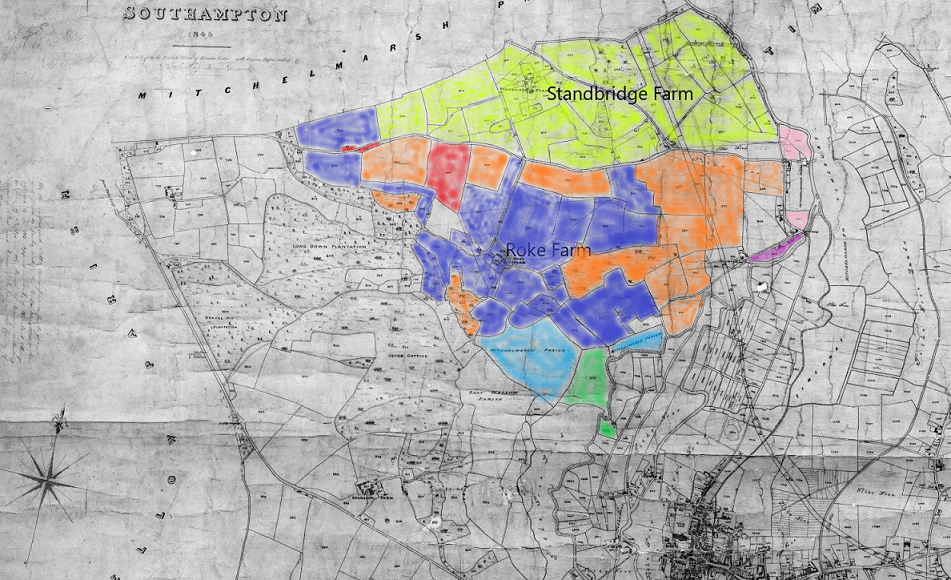
Above is an extract of the 'Map of the titheable lands in the Parish of Romsey including Romsey Infra and Romsey Extra in the County of Southampton. This was at a time when the county name was Southampton or Southamptonshire instead of the more normal Hampshire. Romsey is the town slightly below the shaded areas.
Key to coloured areas;-
| Shading | Landowner | Occupier | |||
| Blue | Job Fifield | Job Fifield | |||
| Orange | Job Fifield & Charles John Hall | Job Fifield | |||
| Yellow | Job Fifield & Charles John Hall | Charles John Hall | |||
| Light green | Anne Julia Daman | Job Fifield | |||
| Pink | Charles John Hall | Charles John Hall | |||
| Mauve | Charles John Hall | Various | |||
| Red | John Fifield | John Fifield | |||
| Light Blue | Job Fifield | Job Fifield | In the Parish of Michelmersh |
By the time of the 'Return of Owners of Land, 1873' for Hampshire, Charles J Hall had lands of 31 acres in Romsey, with an estimated annual rental income of £65. Richard Fifield held lands of 149 acres in Littleton, Hampshire.
Searching the tithe apportionments records of Hampshire, there are several groups of Fifield in addition to this group around Romsey. Winchester also had a Fifieklds in the city council. A Benjamin Fyfield was a Mayor of Romsey.
1721 Benjamin Fyfield, a Tanner http://www.romseynet.org.uk/genealogy/romsey-mayors.pdf Records for Benjamin are held at Hampshire Record Office. Perhaps a trip comming on!
MONUMENTAL INSCRIPTIONS 1661-1761
In my meanderings around the Fifield family, I found the name Humby, and I have a later relative William Edward Humby 1831-1906; father-in-law of 2nd great-aunt who lived in 1 Rose Hill Cottages, Romsey Road, Old Shirley, Millbrook, Hampshire, England. I have found him in the 1871 Census which I have plotted the Enumerators route and William's home on the map below.
more later
John Fiffield d 1796
John Fiffield who died in 1796 was established in his will as elaborated in my article Standbridge and Standbridge Erles
There are various possible spellings of his family's surname, including Fyfielde, Fyfield, Fifeilde, Fiffielde, Fiffield, FFiffield, FFifeld, Fifield and presumably many others. I have adopted Fifield as the collective name for all the variations.
Fifield Name Meaning
English: habitational name from any of various places called Fifield or Fyfield, of which there are instances in Berkshire, Essex, Oxfordshire, and Wiltshire, all so named from Old English fif ‘five’ + hid ‘hide’. (A hide was a measurement of land area.)
I have attempted to transcribe John Fifield's Last Will and Testament within my article Standbridge and Standbridge Erles. Part of that enabled me to derive some of the family.
Family extracted from Will;-
Elizabeth Fifield (illegitimate), John Fifield, Benjamin Fifield, Job Fifield, Richard Fifield, Catharine Fifield. His wife Catherine (1731 - 1800) does not appear to be mentioned in the will, despite still being alive at the time of her husbands death.
| Name | Birth and death | age at Father's death 1796 | age at death |
surviving at Tithe Apportionment - 1840 |
Heir at 1840 | |
| Elizabeth Fifield (illegitimate) | d | 1764 - 1817 | 32 | 53 | No | |
| John Fifield | s | 1766 - | 30 | |||
| Benjamin Fifield | s | 1767 - 1799 | 29 | 32 | No | |
| Job Fifield | s | 1769 - 1840 | 27 | 71 | Yes | |
| Richard Fifield | s | 1770 - 1815 | 26 | 45 | No | |
| Catharine Fifield | d | 1771 - 1846 | 25 | 75 | Yes |
Dates added from Ancestry.
To me this is a good indication of John's family.
There is potentially another John Fifield according to Ancestry, b 1773 d 1827. This would suggest that John b 1766 had died before 1771. However, reading the will, I would have assumed that Jno, or John was the eldest son, which would appear to discount the later John.
However, it appears to be even more complicated than that.
There may be more than meets the eye, especially if some of the Family Trees on Ancestry are anything to go by.
Other family members are possibly;
A potential wife Catherine Pragnell, Born in the year, 1740 at Lockerley, Hampshire, England. In some trees she married a John Web.
Name; Catherine Prangnell
Gender; Female
Marriage Date; 3 Oct 1762
Marriage Place; Mottisfont, Hampshire, England
Spouse; John Webb
Another entry in the same tree,
Name; Cathern Pearse
Gender; Female
Marriage Date; 23 May 1764
Marriage Place; Romsey, Hampshire, England
Spouse; John Fifield
With Catherine Prangnell and Cathern Pearse being one in the same person.
Two children are listed in this tree, Jenny Web b 1793 and Sarah Pragnell 1759 to 1835. Presumably Sarah was born after John Webb and before John Fifield.
There is also a baptism record
Name; Catherine Pragnell
Gender; Female
Spouse; John Fifield
Child; Sarah Pragnell
Another batism record in another tree
Name; Sarah Pragnell
Gender; Female
Baptism Date; 6 Jan 1760
Baptism Place; Lockerley, Hampshire, England
Father; John Fifield
Mother; Catherine Pragnell
Possibly with am annotation of Base Born, which means illegitimate.
Did John Fifield then go on to marry Catherine Pragnell? If so why is Sarah Pragnell not mentioned in the Will even though Elizabeth Fifield (illegitimate) is.
There is also a marriage record
Name; Cathern Pearse
Gender; Female
Marriage Date; 23 May 1764
Marriage Place; Romsey, Hampshire, England
Spouse; John Fifield
Which is the same as above but attributed to a different person.
This record is further confirmed by HGS CD - 23 May 1764 Romsey John Fifield Catharine Pearce. (Hampshire Genealogy Society)
Why is this of such import?
The daughter, Sarah Pragnell married Abraham Hurst on 16 Oct 1780 at Houghton, Hampshire, England. They are my 4th Great Grandparents. This is confirmed with DNA matches as well as a paper trail.
There are also DNA matches which appear to be via the Fifield arm, but the paper trail and Will evidence is less clear.
One possible reason for not being mentioned in the Will is that Sarah Pragnell had already married Abraham Hurst by 1796 when the Will was proved.
Could the marriage to Cathern Pearse or Pearce be either an error in recording the details or in the transcription of the record, with the person being Catherine Pragnell?
Another question is regarding potential similar or same named people within a reasonable proximity.
Below is a collection of extracts of records seeking to find correlations which could help the discussion regarding John Fifield's family. However, looking at the dates, it is likely to be more use with his children than him and his wife. Retained as a potentially useful resource.
St Mary, Michelmersh Parish Records Baptisms 1773 to 1889
| Surname, Christian Name(s) | Other parent surname if unmarried |
Age or Date of Birth |
Date of Baptism |
| Fifield Carly | 10 Jan 1779 | ||
| Fifield Richard | 10 Apr 1780 | ||
| Fifield Henry | 25 Dec 1782 | ||
| Fifield Benjamin | Martin | 23 Apr 1791 |
| Hurst Caroline | 07 May 1793 | ||
| Hurst Isaac | 07 Dec 1794 | ||
| Hurst Harriet | 18 Mar 1798 | ||
| Hurst Charles | 15 Jun 1800 | ||
| Hurst Henry | 10 Nov 1802 | ||
| Hurst Thomas | 25 Jul 1802 | ||
| Hurst Ann | 15 Jul 1804 | ||
| Hurst Sarah | 27 Jul 1806 | ||
| Hurst John | 04 Dec 1808 | ||
| Hurst Elisabeth | 03 Mar 1811 | ||
| Hurst William | 27 Dec 1812 | ||
| Hurst Mary | 15 Feb 1818 | ||
| Hurst Henry | 23 Sep 1832 | ||
| Hurst Matilda | 25 Sep 1844 | ||
| Hurst Ursula | 25 Sep 1844 | ||
| Hurst Tom | Rogers | 29 Jan 1854 | |
| Hurst Henry | Wilton | 27 Jun 1819 |
| Pragnel George | 30 May 1779 | ||
| Pragnell Thomas | 07 Feb 1781 | ||
| Pragnell James | 04 Jun 1786 | ||
| Pragnell Alexander | 03 Nov 1805 | ||
| Pragnell Isaac | 05 Jun 1808 | ||
| Pragnell Mary Anne | 03 Mar 1811 | ||
| Pragnell Mary | 25 Mar 1849 | ||
| Pragnell Ellen | 18 Feb 1866 | ||
| Pragnell Kate | 29 Nov 1868 | ||
| Prangnall Isaac | 12 Oct 1817 | ||
| Prangnel Mary | 02 Jan 1774 | ||
| Prangnell Mary | 02 Sep 1774 | ||
| Prangnell John | 23 Feb 1775 | ||
| Prangnell Elisabeth | 25 Sep 1814 | ||
| Prangnell George | 13 Mar 1831 |
St Mary, Michelmersh Parish Records Marriages 1813 to 1989
Husbands; Fifield or Fyfield none, but some Fielder which may or may not be relevant.
| Husband | Age | Wife | Age | Date of Marriage |
| Fielder | Sillence | 21 Jan 1819 | ||
| Fielder | Butt | 16 May 1826 | ||
| Fielder | 21+ | Wingham | 21+ | 27 Apr 1844 |
| Fielder | 21+ | Collins | 21+ | 17 Jun 1847 |
| Fielder | 21+ | Brice | 21+ | 13 Jun 1850 |
| Fielder | 21+ | Moody | 21+ | 1 Dec 1852 |
| Fielder | 21+ | Bennett | 21+ | 28 Apr 1855 |
| Fielder | 23 | Glasspool | 19 | 9 Apr 1904 |
| Hurst | Curtis | 24 Oct 1816 | ||
| Hurst | Venthamn | 19 May 1832 | ||
| Hurst | 23 | Rogers | 20 | 3 Dec 1853 |
| Hurst | 60 | Batchelor | 57 | 6 Aug 1876 |
| Pragnal | 21+ | White | 21+ | 28 Jan 1842 |
Wifes;
| Wife | Age | Husband | Age | Date of Marriage |
| Fielder | Fox | 28 Dec 1820 | ||
| Fielder | 21+ | Wingham | 21+ | 23 May 1840 |
| Fielder | 37 | Wren | 28 | 27 Jan 1866 |
| Hurst | Wilton | 26 Oct 1815 | ||
| Hurst | Tongs | 29 Jul 1821 | ||
| Hurst | 20 | Baker | 23 | 5 Aug 1868 |
| Hurst | 19 | Ventham | 21 | 29 May 1869 |
| Hurst | 19 | Bailey | 23 | 20 Nov 1875 |
| Pragnell | Curtis | 10 Dec 1834 | ||
| Pragnell | 21+ | Moore | 21+ | 15 Aug 1849 |
| Pragnell | 21+ | Bell | 21+ | 5 Jun 1854 |
St Mary, Michelmersh Parish Records Burials 1813 to 1989
| Surname, Christian name | Date of Burial | Age |
| Fielder Tom | ||
| Fielder Elizabeth | ||
| Fielder Joseph | ||
| Fielder Elizabeth | ||
| Fielder Henry | ||
| Fielder Mary | ||
| Fielder Johanna |
| Hurst James | ||
| Hurst Isaac | ||
| Hurst Mary | ||
| Hurst William | ||
| Hurst Thomas | ||
| Hurst Reginald Douglas | ||
| Hurst Betsy Ann |
| Pragnall Sarah | ||
| Pragnall Ursula | ||
| Pragnole Alexander | ||
| Prangnall Amelia | ||
| Prangnall Mary |
Fifield's of Hampton, New Hampshire, New England
First Fifield immigrant to the New World?

The paragraph below was posted in Ancestry by djsw_ originally shared this on 21 Aug 2008. Source: Readfield Historical Society Newsletter published Spring/Summer 2000
On March 24, 1634, the ship Hercules left London, England. Twenty five days later when the Hercules landed in Ipswich, Massachusetts and her passengers descended the planks - William Fifield was among them. William became one of the original settlers in Hampton, New Hampshire where he was given a grant of land in 1640. On June 2, 1641 he was made a freeman of Massachusetts Bay. William served in several offices in Hampton - attorney, selectman, constable, and sheriff. The Quakers praised him for his humanity. All eight of his children were born in Hampton - the first, John, was born in 1645. In 1648 William's wife, Mary, gave birth to their second son, Benjamin from whom the Fifields of Readfield and Manchester, Maine descend. In 1667 William conveyed land to Benjamin, who was then 19 years of age, and probably anticipating marriage. William saw Benjamin marry, and also enjoyed the birth of Benjamin's nine children. When William, the American Fifield progenitor, died in 1700 he exceeded eighty years of age, and had in fact, lived to see forty of his forty-eight grandchildren enter this world.
For a more complete list of passengers of the Hercules, and a link of William Fifield to Littleton, Hampshire, England.
The Hercules left London, England March 24, 1633/4 and Southampton on April 18, 1634 with her master, John Kiddey, arriving in New England at an unknown date.
The following alphabetical roll is according to document from the Port of Southampton, copied at "the Custom house in Portsmouth" on December 6, 1735, by Thomas Whitehouse
Certificate of March 24, 1633/4, London:
Anthoney, John of Hampstead, Middlesex, bound for Portsmouth, Rhode Island
(John Anthony on certificate for the Mary & John) (Possibly from Hampstead to Portsmouth, RI. 36 pg 110)
Early, Robert
Foster, Thomas of Ipswich, Suffolk, bound for Boston (From Biddenden, Kent, bound for Weymouth and Braintree. Ref: Banks Mss. 36 pg 76)
Foster, William of Ipswich, Suffolk, bound for Ipswich
Hewlett, Matthew
Latcome, William
Certificate of April 16, 1634, Southampton:
Davyes, Nathaniel
(listed as Nathaniel Davis in "Planters of the Commonwealth")
Elliott, William
(listed as William Elliot in "Planters of the Commonwealth")
Fifeilde, William bound for Hampton, New Hampshire
(listed as William Fifield in "Planters of the Commonwealth")
(From Littleton, Hampshire, bound for Hampton, NH. Ref: Banks Mss. 36 pg 61)
Kinge, George
(listed as George King in "Planters of the Commonwealth")
Phelps, Henry bound for Salem, possibly his brother Edward as well
Rider, Thomas bound for Weymouth
See the Unsolved page for names not listed here
Hercules sources:
http://olivetreegenealogy.com/ships/hercules1633.shtml
http://english-america.com/spls/634ne001.html#Hercules
If you choose to use this information or copy this page,
please have the courtesy to include an acknowledgment that the work,
research and compilation was done by Anne Stevens of packrat-pro.com
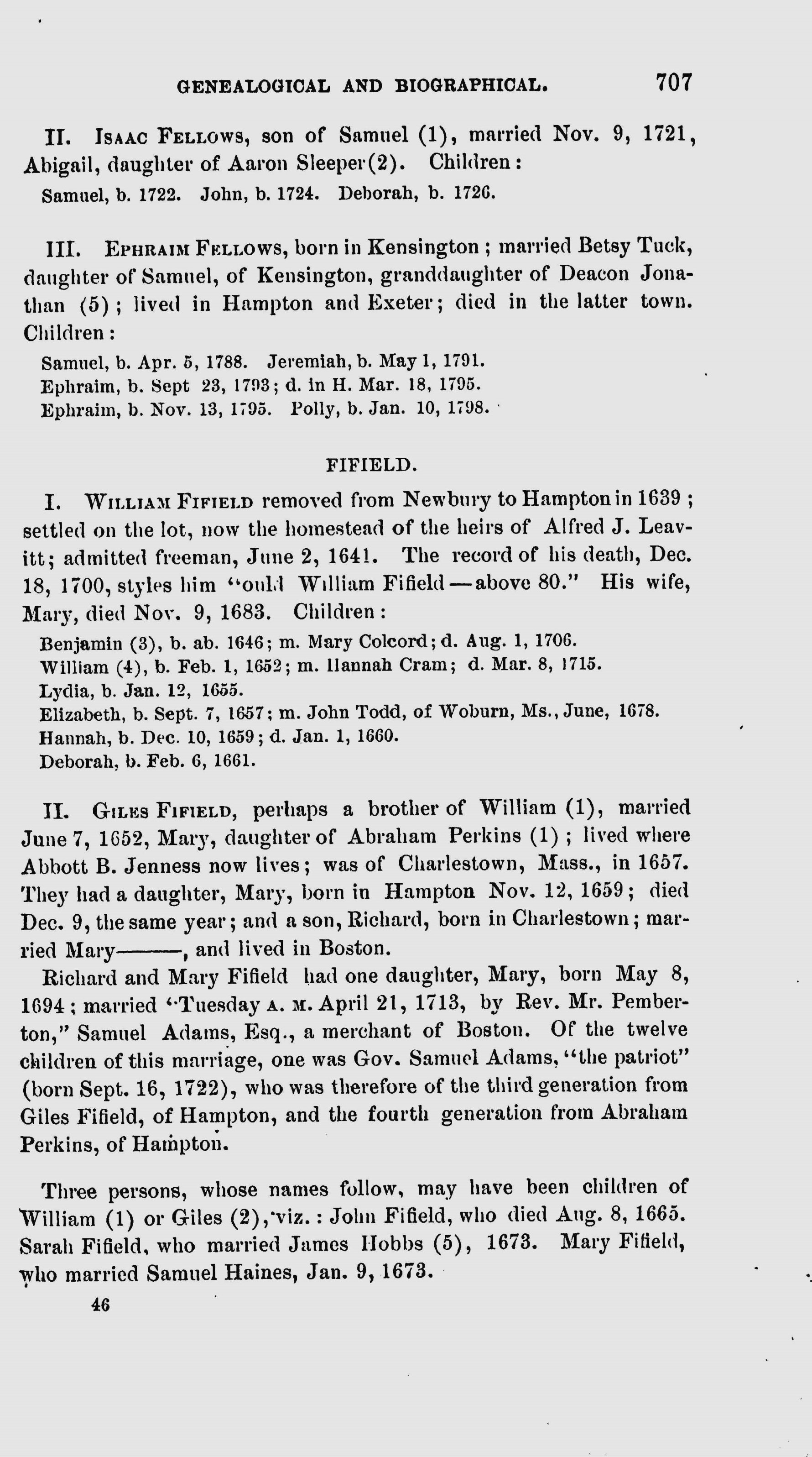
Where is Hampton?
There is a Hi Res version as well.
The book History of the Town of Hampton, New Hampshire, from its settlement in 1638, to the autumn of 1892 by Joseph Dow (Salem Press Publishing) is considered the "bible" of Hampton History. Included with it is a nice historical map of Hampton, "showing the original boundaries of Hampton, as granted in the year 1638."
Extracts from the very informative Hampton Historical Society - Town Records
November 27, 1639 – Wm. Sanborn appointed to ring meeting house bell.
Large grants in acreage (farms) to Mr. Bachiler, Mr. Timothy Dalton, Christopher Hussey, John Cross, John Moulton, Wm. Palmer, Philomon Dalton, Wm. Eastow, William Eastow-
(cont’d) Thomas Moulton, William Wakefield – February 13, 1640 – grants – Richard Swain, Robert Tuck, Robert Saunderson, Thomas Jones (All of the above, with the exception of the Daltons, were original grantees.) James Davis (80 acres), Abraham Perkins (received his in 1640 also. The next list is for house-lots only) – William Sayward, Robert Page, T. Dalton, Jr.,
Jeffrey Mingay, Thos. Ward, Francis Peabody, Arthur Clarke, Samuel Greenfield, Edmund Johnson, widow (?) Hussey, --? illegible, Wm. Fuller, John Huggins, Wm. Marston, John Sanborn, William Sanborn, William Gould, William Sargeant
Wm. English, Barnabas Gorton, John Brown,?__ Cass, Thos. Chase, Francis Aston, Thos. King, Anthony Taylor, Henry Dow, if he come, John Ward, William Fifield, Stephen Sanborn, Wm. Sanborn (spelled Samborne), Henry Moulton, Edward Palmer, Daniel ____?, James Davis, John Wedgewood, Robt. Marston, John Wedgewood, Jr., Giles Fuller, John Philbrick, Tho. Smith, Timothy Dwight, Auila Chase, Daniel ___?, John Brabooke, Robert Sawyer, John Eldward.
November 16, 1653 – John Sanborn and William Fifield to take the lumber that is forfeited to the town. December 16, 1653 – Eastow and J. Sanborn again ordered to survey the areas in question. Nov. 20, 1653 – Regulations on cutting timber.
January 6, 1654 – John Redman demands satisfaction for the remainder of this house lot. Wm. Fifields and William ------ to attend to it.
Same meeting cont’d: Suit of Morris Hobbs against the town. Mr. Stanyan, J. Mingay, and Wm. Fifield to examine matter to represent town.
February 28, 1659 – Abraham Perkins, Jr., Robert Page, Thos. Marston, Wm. Fifield, M. Hobbs to ___?___? affairs of town __ among appointments. T. Sleeper – inhabitant.
113 – Dec.4, 1663 and Feb. 1664 – Order that 2 male inhabitants of the town to sit in the gallery to keep the boys in order during the services. Thos. Sleeper and John Redman assigned for first Sabbath; John Brown and Wm. Fifield to serve second and to inform next pair until all men of town take turns successively. Notices to be given to those profaning the Sabbath to be held court at Hampton.
From the above extracts of the Hampton Town Records and proceedings, William Fifield was actively involved in the Town and its governance in, at a minimum, the period between 1653 and 1664.
Benjamin Fifield
1646–1706
BIRTH 1646 • Hampton, Province of New Hampshire, English Colonies of America
DEATH 1 AUG 1706 • Hampton, Province of New Hampshire, English Colonies of America
Killed by Indians
William Fifield (1652 - 1715) and Hannah Cram
Below is an extract of 'FIFIELD;Newsletter;1991 Vol IV Nos 2;Disc034-20;RELEASED WITH PERMISSION.pdf' Sourced on 9 Jan 2022 from the Guild of One Name Studies
The family of William (2). son of William the immigrant, is not well documented. He married Hannah CRAM at the age of 41 when she was about 20. and died al the age of 63 when most of his children were still minors.
His will reads as follows:
In the Name of God Amen - I William Fifield of Hampton in ye province of New Hampshire in New England being sick & weeke in body but at this present time of perfect understanding & of a disposing minde & memory committing my sole in to the hands of Almighty God and my body to decent burial in hopes of Eternal Life doe thus dispose of my temporal estate which the Lord bath graciously given me.
My Will is that all my just and honest debts be duly paid by my executrix here after named in convenient time after my deathe.
I give and bequeath unto my beloved wife Hannah all my estate of what kind or sort soever be the same houses lands debt stock money, goods & utensils for husbandry all my estate whatsoever within doors or without named or not named Wheresoever or what soever by her to be possessed & improved & disposed of. For ye bringing up my Children & other necessary uses during the tine of her natural life or the time of here widowhood until she marrv the which shall first happen & no longer: and my will is she dispose of all my estate among my children as she shall thinke meet by what parts or portions she shall thinke fit & convenient as to such or so many of my said children as she shall set cause. him. her. or than. to possess & enjoy the same immediately after her decease or marriage as above mentioned. My meaning is what remains undisposed of at her decease or marriage as before said:
And unto this my last will & testament I do appoint my beloved wife Hannah sole executrix by this revoking all wills by me formerly made & sign & seal this with my hand this eighteenth day of February in the first year of King George his reign over Great Britain. ye Anno Dominney 1714/15
Signed scaled & declared by William Fifield to be his last will & testament in presence of ye Witnesses
Robert Moulton
Humphrey Sullivan
Anthony Crosbie
Thomas Haines
Fourteen June 1715
Robert Moulton & Anthony Crosbie formally appearing before me. Richard Watoron Esq. Judge of Probate of Wills and Granting Letters of Administration made oath that they were present and see William Fifield signe seale and Declare ye above Instrument to be his last Will & Testament & at the same time he was of sound disposing mind & memory. Richard Watoron.
The History of Hampton. NH lists the children of William. giving birth dates for Mary Stephen. Henry and Jeremiah and an Estimate of 1704 for Argentine. Mary. Henry-, Jeremiah, Argentine and Samuel were all baptized on 31 October 1708. Son Samuel is listed first in the History. and perhaps this is why Sheppard also lists him first with an estimated birth year of 1694.
Regarding the date based on the first year of King George his reign over Great Britain.
George I (George Louis; German: Georg Ludwig; 28 May 1660 – 11 June 1727) was King of Great Britain and Ireland from 1 August 1714 and ruler of the Duchy and Electorate of Brunswick-Lüneburg (Hanover) within the Holy Roman Empire from 23 January 1698 until his death in 1727. He was the first British monarch of the House of Hanover.
The date of the Will therefore translates to 18th February 1715.
From the note on the History of Hampton, presumably Stephen died before the other children were baptized on 31 October 1708, a kind of job lot.
Still a lot more work to do to join the dots.
Notes from National Archives;
John Fifield of Broad Chalk, Wiltshire, yeoman; Mary Hunt late of Poole, now of Donhead St Mary, Wiltshire, single woman
This record is held by Dorset History Centre
| Reference: | PE/PL/OV 4/1/24 |
|---|---|
| Title: | John Fifield of Broad Chalk, Wiltshire, yeoman; Mary Hunt late of Poole, now of Donhead St Mary, Wiltshire, single woman |
| Date: | 18 Jun 1764 |
| Held by: | Dorset History Centre, not available at The National Archives |
| Language: | English |
| Physical description: | 1 doc |
Short title: Fifield v Fifield. Plaintiffs: Robert Fifield . Defendants: Richard Fifield...
| Reference: | C 6/412/42 |
|---|---|
| Description: |
Short title: Fifield v Fifield. Plaintiffs: Robert Fifield. Defendants: Richard Fifield infant, by Thomas Bramston gent. Subject: The plaintiff's entitlement to an estate as stipulated in the will of Richard Fifield, deceased, his late father, opposed by John Fifield, his late elder brother's son, the deceased's heir at law, who had brought a Chancery suit against The plaintiff questioning the existence of the will: mentions Jane Fifield widow and Edmund Clerke: property in Pauncefoot Worthy manor in Headbourne Worthy, Hampshire and manor of Pauncefoot Worthy, Hampshire. Document type: answer only. |
| Date: | 1697 |
Short title: Fifield v Fifield. Plaintiffs: Robert Fifield gent, of Worthy Pauncefoot,...
Ordering and viewing options
This record has not been digitised and cannot be downloaded.
You can order records in advance to be ready for you when you visit Kew. You will need a reader's ticket to do this. Or, you can request a quotation for a copy to be sent to you.
| Reference: | C 6/413/99 |
|---|---|
| Description: |
Short title: Fifield v Fifield. Plaintiffs: Robert Fifield gent, of Worthy Pauncefoot, Hampshire. Defendants: Jane Fifield (alias Jane Broadway) widow, Richard Fifield and Zachary Broadway. Subject: The plaintiff's entitlement to an estate claimed by his late elder brother's widow and son: mentions Richard Fifield, John Fifield and Edmund Clarke: Abbots Farm, Headbourne Worthy, Hampshire; Pauncefoot Worthy manor, Headbourne Worthy, Hampshire and manor of Pauncefoot Worthy, Hampshire. Document type: answer only. |
